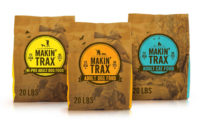Market Trends: Pet Food
Precise, personalized pet food packaging pampers pets and owners


“I and love and you” creates color-coded containers for easier shopping.

Source: U.S. Pet Market Outlook, 2014-2015, Packaged Facts















According to a recent study from Freedonia (freedoniagroup.com), the US demand for pet food is expected to rise close to 4% annually through 2018. That only makes sense, considering Packaged Fact’s (packagedfacts.com) report U.S. Pet Market Outlook, 2014-2015, showed that pet ownership is on the rise. Pet ownership isn’t the only thing on the rise, either. Pet owners are more concerned with the health of their pets.
Another report from Packaged Facts, Natural, Organic, and Eco-Friendly Pet Products in the U.S., 5th Edition, estimated that natural pet products were on track to exceed $7 billion in 2014, with natural pet food sales expected to reach $6.6 billion. Packaged Facts surveyed pet owners and found that 68% of pet owners are willing to spend more on high quality pet foods to ensure the health of their pets. The survey also showed that 62% of pet owners check labels on pet food and 42% are concerned about their pets having allergies or food intolerances. As more pet owners are concerned for the health of their pets and as premium pet food brands compete for consumer attention, packaging plays a major role in helping consumers connect with the brands that best suit their needs.
Personalized for pups
Last year, Coco-Cola released personalized bottles and cans with a variety of names on them, but personalization isn’t just for “persons” anymore. Nestlé Purina is bringing custom pet food and packaging to canine companions. According to Purina’s research, 70% of dog owners want food that supports their dog’s needs. Because of that, they are launching Just Right by Purina through the website JustRightPetFood.com.
“Every dog is unique and that’s why we believe the best solutions are personalized,” says Brian Lester, director of marketing, Just Right by Purina. “No one knows a dog as well as its owner. By combining a dog owner’s firsthand knowledge of their pet with Purina’s expertise, we can work together to help keep dogs happy and healthy throughout their lives.”
Dog owners simply need to visit the website; answer questions about their dog’s age, breed, health and lifestyle; and select their preferences for key ingredients to create their own unique mix of food. The personalization continues onto the packaging where pet owners have the option of including their dog’s name and picture. The package will also list feeding instructions specific for each dog’s needs.
Color-coded cuisine
Pet care brand “I and love and you” has launched new packaging designs that not only showcase their new logo for stronger brand recognition but also feature color-coding to help pet owners find the perfect products quickly and easily. The color-coding begins with the base color of the package, which uses white for dogs and silver for cats. The top and bottom banner colors note the type of food such as green for raw food, purple for kibble, teal for chews and so on. Additional colors on the package indicate the recipe flavors such as blue for seafood, red for beef, orange for poultry, etc.
“We wanted to make product selection easier and more intuitive,” says Steve Ball, “I and love and you” CEO and co-founder. “The refreshed designs improve shoppablity within the “I and love and you” set, making it much simpler for pet parents to find exactly what they’re looking for by utilizing the fun, modern color cues. The refreshed design works both functionally and emotionally to communicate features and benefits along with the brand’s unique and fun personality, which is a huge differentiator in the pet category.”
Additionally, the new packages include health and wellness icons on the front to show pet owners the health benefits of the food such as dental health, digestive support and joint maintenance. Both the front and back of the new packages help meet consumer demand for clear nutrition information by providing ingredient-driven imagery and improved product benefit communication.
As pet food variety continues to increase, packagers will be called on to make the food selection process simpler and clearer for pet owners. According to the aforementioned Freedonia’s pet food packaging study, pet food manufacturers can differentiate their products with unique packaging. The study shows that the rise of natural pet food has coincided with a rise in paper-based packaging with a natural finish. Foods are also coming in smaller, reclosable packaging for easier display and handling. Pet food packaging continues to echo the more natural, more diverse landscape of pet foods available to consumers.
Looking for a reprint of this article?
From high-res PDFs to custom plaques, order your copy today!
















